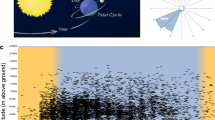Abstract
We present evidence from experiments on overwintering populations of two Palearctic-Indian latitudinal migratory birds, the black-headed bunting (Emberiza melanocephala) and the red-headed bunting (E. bruniceps), that the bird’s clock in interaction with day length regulates seasonal rhythms of migration and reproduction such that physiological conflict between them is reduced. Initiation and termination of the body mass and testicular cycles are separately regulated photoperiodic events. For example, under stimulatory photoperiods the response curve of body mass does not overlap with that of the testicular growth. A response-specific photoperiodism is adaptive, since gain in body mass, critical to spring migration, precedes gonadal recrudescence. Finally, migration as indicated by the night-time migratory restlessness under experimental situations (e.g., intense locomotion under caged condition-called Zugunruhe) appears to be regulated by a separate circadian oscillator.




Similar content being viewed by others
References
Ali S, Ripley SD (1974) Handbook of birds of India and Pakistan, 2nd ed, vol 10. Oxford University Press, Delhi
Aschoff J, Pohl H (1978) Phase relations between a circadian rhythm and its zeitgeber within the range of entrainment. Naturwissenschaften 65:80–84
Berthold P (1996) Control of bird migration. Chapman and Hall, London
Berthold P, Querner U (1988) Was Zugunruhe wirklich ist: Eine quantitative Bestimmmung mit Hilfe von Video-Aufnahmen bei Infrarotbeleuchtung. J Ornithol 129:372–375
Bhatt D, Chandola A (1985) Circannual rhythm of food intake in spotted munia and its relationship with fattening and reproductive cycles. J Comp Physiol 156:429–432
Binkley S (1990) The clockwork sparrow. Time, clock and calendars in biological organisms. Prentice Hall, Englewood Cliffs
Daan S, Aschoff J (1975) Circadian rhythms of locomotor activity in captive birds and mammals: their interaction with seasons and latitude. Oecologia 18:269–316
Dawson A, King VM, Bentley GE, Ball GF (2001) Photoperiodic control of seasonality in birds. J Biol Rhythms 16:365–380
Eskin A (1971) Some properties of the system controlling the circadian activity rhythm of sparrows. In: Menaker M (ed) Biochronometry. AAAS, Washington, pp 55–80
Gwinner E (1972) Adaptive functions of circannual rhythms in warblers. In: Proc Int Ornithol Congr 15:218–236
Gwinner E (1975) Circadian and circannual rhythms in birds. In: Farner DS, King JR (eds) Avian biology, vol 5. Academic Press, New York, pp 221–285
Gwinner E (1986) Circannual rhythms in the control of avian migrations. Adv Stud Behav 16:191–228
Gwinner E (1996) Circadian and circannual programmes in avian migration. J Exp Biol 199:39–48
Gwinner E, Helm B (2003) Circannual and circadian contributions to the timing of avian migration. In: Berthold P, Gwinner E, Sonnenschein F (eds) Avian migration. Springer, Berlin Heidelberg New York, pp 81–95
Jain N, Kumar V (1995) Changes in food intake, body weight, gonads and plasma concentrations of thyroxine, luteinizing hormone and testosterone in captive buntings exposed to natural daylengths at 29°N. J Biosci 20:417–426
Kumar V (1997) Photoperiodism in higher vertebrates—an adaptive strategy in temporal environment. Indian J Exp Biol 35:427–437
Kumar V (2001) Melatonin and circadian rhythmicity in birds. In: Dawson A, Chaturvedi CM (eds) Avian endocrinology. Narosa Publishing House, New Delhi, pp 93–112
Kumar V, Follett BK (1993) The nature of photoperiodic clock in vertebrates. Proc Zool Soc Calcutta, JBS Haldane Commemoration Vol, pp 217–227
Kumar V, Kumar BS (1995) Entrainment of circadian system under variable photocycles (T-photocycles) alters the critical daylength for photoperiodic induction in blackheaded buntings. J Exp Zool 273:297–302
Kumar V, Rani S (1999) Differential responses to complete and corresponding skeleton photoperiods in male blackheaded bunting. Curr Sci 77:283–285
Kumar V, Jain N, Follett BK (1996) The photoperiodic clock in blackheaded buntings (Emberiza melanocephala) is mediated by self-sustaining circadian system. J Comp Physiol A 179:59–64
Lincoln GA, Anderson H, Loudon A (2003) Clock genes in calendar cells as the basis of annual timekeeping in mammals—a unifying hypothesis. J Endocrinol 179:1–13
Malik S, Rani S, Kumar V (2002) The influence of light wavelength on phase-dependent responsiveness of the photoperiodic clock in migratory blackheaded bunting. Biol Rhythm Res 33:65–73
Malik S, Rani S, Kumar V (2004) Wavelength dependency of light induced effects on photoperiodic clock in the migratory blackheaded bunting (Emberiza melanocephala). Chronobiol Int 21:358–367
Misra M (2002) Photoperiodic control of seasonal responses in migratory buntings (Emberiza sp). PhD Thesis, University of Lucknow, Lucknow
Misra M, Rani S, Singh S, Kumar V (2004) Regulation of seasonality in the migratory male blackheaded bunting (Emberiza melanocephala). Reprod Nutr Dev 44:341–352
Nicholls TJ, Goldsmith AR, Dawson A (1988) Photorefractoriness in birds and comparison with mammals. Physiol Rev 68:133–176
Pohl H (2000) Circadian control of migratory restlessness and the effects of exogenous melatonin in the brambling, Fringilla montifringilla. Chronobiol Int 17:471–488
Pittendrigh CS, Daan S (1976) A functional analysis of circadian pacemakers in nocturnal rodents. V. Pacemaker structure: a clock for all seasons. J Comp Physiol 106:333–355
Rani S, Singh S, Kumar V (2002) Light sensitivity of the biological clock. In: Kumar V (ed) Biological rhythms. Narosa Publishing House, New Delhi, pp 232–243
Rani S, Singh S, Misra M, Malik S, Singh BP, Kumar V (2005) Daily light regulates seasonal responses in the migratory male redheaded bunting (Emberiza bruniceps). J Exp Zool 303A:541–550
Singh S, Misra M, Rani S, Kumar V (2002) Photoperiodic entrainment and induction of circadian clock regulating seasonal responses in the migratory blackheaded bunting. Chronobiol Int 19:865–881
Wagner HO (1930) Über Jahres- und Tagesrhythmus bei Zugvögeln. Z Vergl Physiol 12:703–724
Acknowledgements
The experiments included in this paper conform to Indian law, and were carried out in the facilities generated from the SERC research grant to V.K. by the Department of Science and Technology, Government of India.
Author information
Authors and Affiliations
Corresponding author
Additional information
Communicated by F. Bairlein
Rights and permissions
About this article
Cite this article
Kumar, V., Rani, S. & Singh, B.P. Biological clocks help reduce the physiological conflicts in avian migrants. J Ornithol 147, 281–286 (2006). https://doi.org/10.1007/s10336-006-0055-7
Received:
Revised:
Accepted:
Published:
Issue Date:
DOI: https://doi.org/10.1007/s10336-006-0055-7




